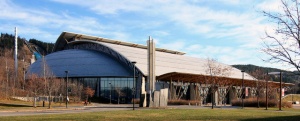Håkons Hall
| Håkons Hall | |
|---|---|

| |
| Location | Stampesletta, Lillehammer, Norway |
| Opened | 1 February 1993 |
| Owner | Lillehammer Olympiapark |
| Construction cost | NOK 238 million |
| Main Contractors | Veidekke |
| Tenants | 1994 Winter Olympics 1999 IIHF World Championship |
| Capacity | 11,500 |
Håkons Hall, sometimes anglicized as Håkon Hall and Haakons Hall, is an arena located at Stampesletta in Lillehammer, Norway. With a spectator capacity of 11,500 people, it is the largest handball and ice hockey venue in the country. Håkons Hall is regularly used for handball and ice hockey tournaments, concerts, exhibitions, conferences and banquets. The venue is owned by Lillehammer Municipality via the subsidiary Lillehammer Olympiapark, which owns all the Olympic venues in Lillehammer. The Norwegian Olympic Museum is located in the arena, which is located next to the smaller Kristins Hall.
Construction

Lillehammer received its first indoor ice rink in 1988, with the opening of Kristins Hall. That same year, the town was awarded the 1994 Winter Olympics, which required the construction of a larger venue for the Olympic ice hockey matches. The naming of the arena was decided by the Lillehammer Municipal Council in October 1988, as part of a broader branding policy, based on the history of the Birkebeiner. Håkons Hall is named for Haakon Haakonarson, a medieval king of Norway who as a child was transported across by mountains by skiers. Kristin and Håkon became the mascots for the Olympics, and the twin arenas at Stampesletta were named accordingly. Protests were made in Bergen, as local patriots felt it was not suitable that a sports venue had such a similar name to Håkonshallen, a medieval hall in Bergen.[1]
In June 1989, the municipal council voted to locate most of the Lillehammer venues in the Stampesletta area, and to place Håkons Hall adjacent to Kristins Hall. This was controversial and many councilors voted for the original decentralized plan, with the venues spread out through the municipality.[2] The application for the Olympics called for building up to five ice venues in Lillehammer. For post-Olympic use, Kristins Hall was designated as the main ice rink for Lillehammer, while it was planned that Håkons Hall would be used for larger events.[3] On 8 December 1989, the International Olympic Committee rejected two demands from the International Ice Hockey Federation (IIHF) for the ability to host a minimum of 12,000 spectators in the larger ice hockey venue and for a women's ice hockey tournament.[4]
The decision about the location of the ice hockey venues was made on 10 October 1990. Håkons Hall would be the main venue, supplemented by Gjøvik Olympic Cavern Hall in Gjøvik. The proposal to have figure skating at Håkons Hall was rejected, and instead it was to be held at Hamar Olympic Amphitheatre in Hamar.[5] In 1990, Håkons Hall was proposed to supplement Oslo Spektrum as a venue for a proposed pan-European professional ice hockey league.[6] Construction was approved by the Parliament of Norway in April 1990, including funding.[7] Original design plans called for a simple hangar-like design, and original cost estimates were for NOK 191 million. However, in March 1991, the municipal council decided to increase spending on the venue to make it more aesthetic. The re-design also included telescopic stands and better acoustics, to allow for more flexible use after the Olympics.[8]
The main contractor was Veidekke and construction cost NOK 238 million. Grants were given from the Norwegian Water Resources and Energy Directorate and SINTEF for energy economization. The work on the hall was concluded on 1 February 1993.[7] It was the 27th indoor ice hockey rink in Norway.[9]
Events
During the 1994 Winter Olympics, Håkons Hall hosted the ice hockey tournament along with Gjøvik Olympic Cavern Hall between 12 and 26 February. Håkons Hall hosted 21 games, including the final which saw Sweden beat Canada in a penalty shootout.[10] In the 1994 Winter Paralympics, Håkons Hall was used for the opening and closing ceremonies.[11]
Lillehammer IK plays its home matches at Kristins Hall, but in 1995 the play-off match between it and neighbor town rivals Storhamar Dragons was played at Håkons Hall. The match saw more than 5,000 spectators, the record for Lillehammer IK.
Norway hosted the 1999 IIHF Ice Hockey World Championship in Oslo, Lillehammer and Hamar. Håkons Hall featured Group D, consisting of Russia, Finland, Belarus and Kazakhstan, as well as the semi-finals, the bronze final and the final. Tickets were sold as twins, with two games being staged with a one-hour interlude on the same ticket.[12]
References
- ↑ Svegaarden, Knut Espen. "Håkons hall valgt blant mange forslag", Bergens Tidende, 7 January 1992, p. 43. (Norwegian)
- ↑ "LOOC støtter rådmann-instilling, OL-anleggene samles rund Stampesletta?", 19 June 1989. (Norwegian)
- ↑ Kirkebøen, Stein Erik. "Er OL verd pengene?", Aftenposten, 2 May 1989, p. 16. (Norwegian)
- ↑ "Svart OL-dag for ishockeysjefen", 8 December 1989. (Norwegian)
- ↑ "OL-ishockey på Lillehammer og GJøvik", 10 October 1990. (Norwegian)
- ↑ "Europeisk superliga i ishockey neste sesong?", 6 September 1990. (Norwegian)
- ↑ 7.0 7.1 Lillehammer Olympic Organizing Committee. "1994 Winter Olympics Report, volume III". pp. 27–29. http://www.la84foundation.org/6oic/OfficialReports/1994/E_BOOK3.PDF. Retrieved 10 December 2010.
- ↑ "Håkons hall blir lillehammers "juvel"", 21 March 1991. (Norwegian)
- ↑ Norwegian Ice Hockey Association. "Ishaller" (in Norwegian). Archived from the original on 7 February 2011. http://www.hockey.no/t2.asp?p=61305. Retrieved 7 February 2011.
- ↑ Gleditsch, Knut Th. (1994). Olympiske vinterleker Lillehammer 1994 (in Norwegian). Notabene Forlag, 288.
- ↑ "Kjølig forhold mellom IOK og paralympics", 9 March 1994. (Norwegian)
- ↑ "–Vi appellerer til OL-ånden", Aftenposten Aften, 1 September 1998, p. 19. (Norwegian)
| This page uses Creative Commons Licensed content from Wikipedia (view authors). |